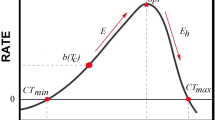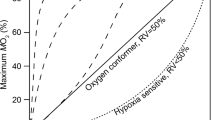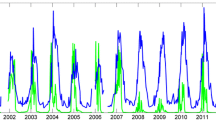Abstract
Although the oyster drill Urosalpinx cinerea (Say) is often cited as an example of a species which has formed physiological races among populations experiencing different thermal conditions, temperature effects on the respiratory metabolism of this organism have not been studied. Acclimated metabolism-temperature curves were constructed for 4 latitudinally separated populations which include two subspecies. Virginia U. cinerea follyensis, and Massachusetts and Maine U. cinerea cinerea, exhibit the classical pattern of latitudinal compensation of oxygen consumption, apparently due to an inverse size-latitude relationship which is contrary to Bergmann's rule. It is suggested that this anomaly may have resulted from the selective development of a smaller maximum size in the northern populations, although transportation of drills by man along the Atlantic coast has probably confused the situation. For reasons not immediately apparent, the Massachusetts individuals show rates consistently lower than those of the North Carolina, Virginia, and Maine speciments.
Similar content being viewed by others
Literature cited
Allee, W. C.: Studies in marine ecology: IV. The effect of temperature in limiting the geographical range of invertebrates of the Woods Hole littoral. Ecology 4, 341–354 (1923).
Baker, B. B.: Interesting shells from the Delmarva Peninsula. Nautilus 64, 73–77 (1951).
Blake, J. W. and M. R. Carriker: Inherent differences between populations of the oyster-drilling gastropod, Urosalpinx cinerea, reared under laboratory conditions. Second International Oceanographical Congress, Moscow. (Abstract) 1966.
Carriker, M. R.: Critical review of the biology and control of oyster drills Urosalpinx and Eupleura. Spec. scient. Rep. U.S. Fish Wildl. Serv. (Fisheries) 148, 1–150 (1955).
Cerame-Vivas, M. J. and L. E. Gray: The distributional pattern of benthic invertebrates of the continental shelf off North Carolina. Ecology 47, 260–270 (1966).
Coast and Geodetic Survey: Surface water temperature and density Atlantic coast North and South America. C. & G. S. Publ. 31-1 3rd ed., 102 pp. Washington: Government Printing Office 1968.
Davies, P. S.: Physiological ecology of Patella. I. The effect of body size and temperature on metabolic rate. J. mar. biol. Ass. U.K. 46, 647–658 (1966).
Dehnel, P. A.: Rates of growth of gastropods as a function of latitude. Physiol. Zoöl. 28, 115–144 (1955).
Démeusy, N.: Respiratory metabolism of the fiddler crab Uca pugilator from two different latitudinal populations. Biol. Bull. mar. biol. Lab., Woods Hole 113, 245–253 (1957).
Ekman, S.: Zoogeography of the sea, 417 pp. London: Sidgwick & Jackson 1953.
Federighi, H.: Studies on the oyster drill (Urosalpinx cinerea Say). Bull. Bur. Fish., Wash. 47, 83–115 (1931).
Franz, D. R.: Population age structure, growth and longevity of the marine gastropod Urosalpinx cinerea Say. Biol. Bull. mar. biol. Lab., Woods Hole 140, 63–72 (1971).
Ganaros, A. E.: On development of early stages of Urosalpinx cinerea (Say) at constant temperatures and their tolerance to low temperatures. Biol. Bull. mar. biol. Lab., Woods Hole 114, 188–195 (1958).
Green, R. H. and K. D. Hobson: Spatial and temporal structure in a temperate intertidal community, with special emphasis on Gemma gemma (Pelecypoda: Mollusca). Ecology 51, 999–1011 (1970).
Hanks, J. E.: The rate of feeding of the common oyster drill, Urosalpinx cinerea (Say), at controlled water temperatures. Biol. Bull. mar. biol. Lab., Woods Hole 112, 330–335 (1957).
Hargis, W. J.: A rapid live-sexing technique for Urosalpinx cinerea and Eupleura caudata, with notes on previous methods. Limnol. Oceanogr. 2, 41–42 (1957).
Haskin, H. H.: Investigations on the boring and reproductive activities of the oyster drills Urosalpinx cinerea Say and Eupleura sp. U.S. Bur. Fish., Wash. (1935). (Unpubl. m/s).
Heuts, M. J.: Experimental studies on sdaptive evolution in Gasterosteus aculeatus L. Evolution 1, 89–102 (1947).
—: Temperature adaptation in Gasterosteus aculeatus L. Pubbl. Staz. zool. Napoli 28, 44–61 (1956).
Johnson, C. W.: List of marine mollusca of the Atlantic coast from Labrador to Texas. Proc. Boston Soc. nat. Hist. 40, 1–204 (1934).
Jones, M. L.: The presence of certain dehydrogenases among polychaetous annelids as shown by disc electrophoresis. Comp. Biochem. Physiol. 36, 605–611 (1970).
Kinne, O.: Irreversible nongenetic variation. Comp. Biochem. Physiol. 5, 265–282 (1962).
Kroch, A.: The respiratory exchange of animals and man, 173 pp. New York: Longman, Green & Co. 1916.
Loosanoff, V. L. and H. C. Davis: Behavior of drills of different geographical districts at the same temperatures. U.S. Fish Wildl. Serv. (1950–1951). (Unpubl. m/s).
Mangum, C. P.: Studies on speciation in maldanid polychaetes of the North American Atlantic coast. III. Intraspecific and interspecific divergence in oxygen consumption. Comp. Biochem. Physiol. 10, 335–349 (1963).
—: Studies on speciation in maldanid polychaetes of the North American Atlantic coast. II. Distribution and competitive interaction of five sympatric species. Limnol. Oceanogr. 9, 12–26 (1964).
Manzi, J. J.: Combined effects of salinity and temperature on the feeding, reproductive, and survival rates of Eupleura caudata (Say) and Urosalpinx cinerea (Say) (Prosobranchia: Muricidae). Biol. Bull. mar. biol. Lab., Woods Hole 138, 35–46 (1970).
Owen, H. M.: Observations on oyster drills: chromosomes of Urosalpinx cinereus Say. Conv. Address, Nat. Shellfish Ass. (Abstract) (1947).
Page, E. R. I.: Whole-animal respiration studies of Urosalpinx and Eupleura. Bur. comml Fish., Maryland (1968). (Unpubl. m/s).
Prosser, C. L.: Physiological variation in animals. Biol. Rev. 30, 229–262 (1955).
—: Perspectives of adaptation: theoretical aspects. In: Handbook of physiology, Sect. 4, pp 11–25. Ed. by D. B. Dill, E. F. Adolph and C. G. Wilber. Washington: American Physiological Society 1964.
— and F. A. Brown, Jr.: Comparative animal physiology, 688 pp. Philadelphia: Saunders 1961.
Ray, C.: The application of Bergmann's and Allen's rules to the poikilotherms. J. Morphol. 106, 85–108 (1960).
Regnouf, F. and N. Van Thoai: Octopine and lactate dehydrogenases in mollusc muscles. Comp. Biochem. Physiol. 32, 411–416 (1970).
Roberts, J. L.: Thermal acclimation of metabolism in the crab Pachygrapsus crassipes Randall. I. The influence of body size, starvation, and molting. Physiol. Zoöl. 30, 232–242 (1957a).
—: Thermal acclimation of metabolism in the crab Pachygrapsus crassipes Randall. II. Mechanisms and the influence of season and latitude. Physiol. Zoöl. 30, 242–255 (1957b).
Sandeen, M. I., G. C. Stephens and F. A. Brown, Jr.: Persistent daily and tidal rhythms of oxygen consumption in two species of marine smails. Physiol. Zoöl. 27, 350–356 (1954).
Sassaman, C. and C. P. Mangum: Patterns of temperature adaptation in North American Atlantic coastal actinians. Mar. Biol. 7, 123–130 (1970).
Schneider, D. E.: Temperature adaptations in latitudinally separated populations of the crab Rhithropanopeus harrisii. Am. Zool. 8, p. 772 (1968). (Abstract).
Shaw, C. R. and A. L. Koen: Starch gel zone electrophoresis of enzymes. In: Chromatographic and electrophoretic techniques, Vol. II. Zone electrophoresis, pp 325–364. Ed. by I. Smith. New York: Interscience 1968.
Stauber, L. A.: Ecological studies on the oyster drill, Urosalpinx cinerea, in Delaware Bay, with notes on the associated drill, Eupleura caudata, and with practical considerations of control methods. (1943). (Unpubl. m/s).
—: The problem of physiological species with special reference to oysters and oysters drills. Ecology 31, 109–118 (1950).
Steel, R. G. D. and J. H. Torrie: Principles and procedures of statistics, with special reference to the biological sciences, 481 pp. New York: McGraw-Hill 1960.
Stickle, W. B. and F. G. Duerr: The effects of starvation on the respiration and major nutrient stores of Thais lamellosa. Comp. Biochem. Physiol. 33, 689–695 (1970).
Vernberg, F. J.: Studies on the physiological variation between tropical and temperate zone fiddler crabs of the genus Uca. III. The influence of temperature acclimation on oxygen consumption of whole organisms. Biol. Bull. mar. biol. Lab., Woods Hole 117, 582–593 (1959).
— and W. B. Vernberg: Lethal limits and the zoogeography of the faunal assemblages of coastal Carolina waters. Mar. Biol. 6, 26–32 (1970).
Walter, H. E.: Variations in Urosalpinx. Am. Nat. 44, 577–594 (1910).
Welis, H. W. and I. E. Gray: The seasonal occurrence of Mytilus edulis on the Carolina coast as a result of transport around Cape Hatteras. Biol. Bull. mar. biol. Lab., Woods Hole 119, 550–559 (1960).
Wood, L.: Physiological and ecological aspects of prey selection by the marine gastropod Urosalpinx cinerea (Prosobranchia: Muricidae). Malacologia 6, 267–320 (1968).
Author information
Authors and Affiliations
Additional information
Communicated by J. Bunt, Miami
Rights and permissions
About this article
Cite this article
Shick, J.M. Temperature sensitivity of oxygen consumption of latitudinally separated Urosalpinx cinerea (Prosobranchia: Muricidae) populations. Marine Biology 13, 276–283 (1972). https://doi.org/10.1007/BF00348074
Accepted:
Issue Date:
DOI: https://doi.org/10.1007/BF00348074




